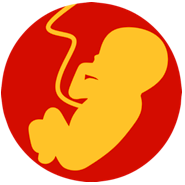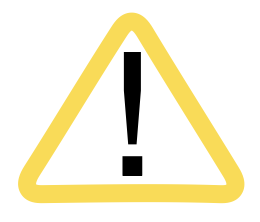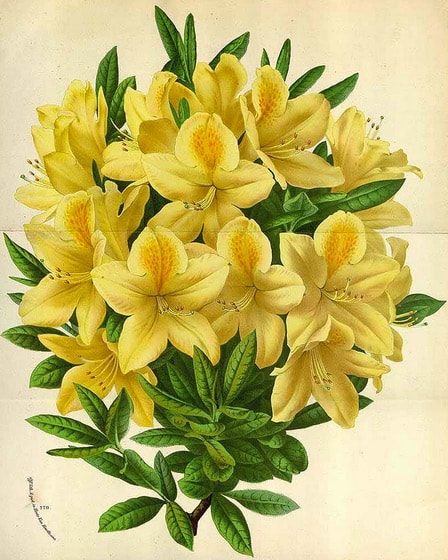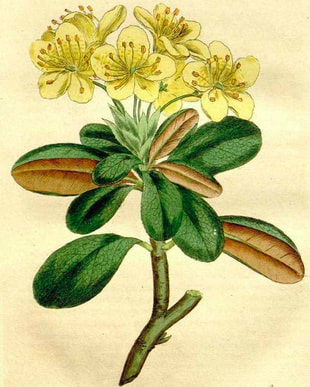Sentry Page Protection
Rhododendron molle
Houtte, L. van, Flore des serres et des jardin de l’Europe, vol. 19 (1845)
Houtte, L. van, Flore des serres et des jardin de l’Europe, vol. 19 (1845)
Rhododendron chrysanthum
Woodville, W., Hooker, W.J., Spratt, G., Medical Botany, 3th edition, vol. 2 (1832)
Woodville, W., Hooker, W.J., Spratt, G., Medical Botany, 3th edition, vol. 2 (1832)
Botanical name:
Rhododendron molle (syn. R. sinensis, Azalea molle)
The related European R. chrysanthum (syn. R. aureum, R. officinale) appears to have been used similarly
Parts used:
Flower
The leaf of the European R. chrysanthum is used
Temperature & Taste:
Warm, dry. Pungent. Very Toxic
Constituents:
Alkaloids: scopolamine, hyoscamine and atropine
Rhododendron molle (syn. R. sinensis, Azalea molle)
The related European R. chrysanthum (syn. R. aureum, R. officinale) appears to have been used similarly
Parts used:
Flower
The leaf of the European R. chrysanthum is used
Temperature & Taste:
Warm, dry. Pungent. Very Toxic
Constituents:
Alkaloids: scopolamine, hyoscamine and atropine
Uses:
1. Clears Wind-Damp, Eases Pain: (TCM, West)
-Rheumatism, Rheumatic Arthralgia
-Paralysis, Hemiplegia
-chronic Eczema, Neurodermatitis
-Rhinitis, Sinusitis (Mongolian Medicine)
-'severe pain in the skin due to attack of pathogenic Wind'. (Shen Nong Ben Cao)
2. Settles Wind, Moves the Blood, Clears Stasis:
-Tachycardia, Palpitation
-Wind Stroke (Apoplexy) (old TCM)
-Hypertension
-Trauma, Bruising
3. Kills Worms
-Ringworm, Scabies
4. Externally:
-Tooth caries, tooth caries
-fresh herb is beaten and applied topically to relieve Migraine headache
-Trauma, fry in wine and apply
Dose:
It is only used in small doses in compounds with other drugs.
In pills or powders: 300–600mg
Infused in Wine: 600–1500mg
Topically, a strong decoction can be used as a wash, or the fresh flower can be beaten to a paste for application.
Comment:
1. The primary function is for Rheumatic and joint pain for which the European variety has been also used. The other functions given are for the Chinese variety.
2. The fruit is also used, called Nao Yang Hua Zi. It has similar effects and is used for Wind-Damp arthritic pain, Trauma. It is also used for Cough and Asthma, and for swollen Abscesses. Other parts of the plant have been used including leaf, root and stem.
Preparation:
1. Steamed Flower Cake:
Beat the flowers into a paste and form into a cake. Steam the cake, then hang it in a sack. Bake it dry and grind to powder. Make pills the size of a parasol seed. Dose is 3 pills per dose with wine. 'Very effective' for wandering pain. (Xu Chuan Xin Fang, TCM)
2. Wine Steamed Flower Cake:
Beat the flower and mix with wine, then steam for as long as it takes to cook a meal. Dry in the sun, then powder. (Tai Ping Sheng Hui Fang, TCM)
It is only used in small doses in compounds with other drugs.
In pills or powders: 300–600mg
Infused in Wine: 600–1500mg
Topically, a strong decoction can be used as a wash, or the fresh flower can be beaten to a paste for application.
Comment:
1. The primary function is for Rheumatic and joint pain for which the European variety has been also used. The other functions given are for the Chinese variety.
2. The fruit is also used, called Nao Yang Hua Zi. It has similar effects and is used for Wind-Damp arthritic pain, Trauma. It is also used for Cough and Asthma, and for swollen Abscesses. Other parts of the plant have been used including leaf, root and stem.
Preparation:
1. Steamed Flower Cake:
Beat the flowers into a paste and form into a cake. Steam the cake, then hang it in a sack. Bake it dry and grind to powder. Make pills the size of a parasol seed. Dose is 3 pills per dose with wine. 'Very effective' for wandering pain. (Xu Chuan Xin Fang, TCM)
2. Wine Steamed Flower Cake:
Beat the flower and mix with wine, then steam for as long as it takes to cook a meal. Dry in the sun, then powder. (Tai Ping Sheng Hui Fang, TCM)
Main Combinations:
1. Rhinitis, Sinusitis, Rhododendron flower with Chebula, Costus, Indian Spikenard (Mongolian Medicine)
2. For Wind-Damp, Wind-Phlegm, and to ease Pain, Rhododendron flower with Arisaema Tian Nan Xing. (Xu Chuan Xing Fang)
3. Arthralgia, Rheumatic pain:
i. Rhododendron flower (1 handful) with Glutinous Rice (1 cup) and Black Soy Bean (half cup). Decoct in one cup of water and one cup of wine. Drink small amounts each time. After one dose there will be vomiting and diarrhea. (Yi Xue Ji Cheng, TCM)
ii. the leaf of R. chrysanthum has been combined with Aconite in Europe. (Sobernheim, 1840)
4. Wind-Stroke with pain, Rhododendron flower with Scorpion Quan Xie (fried), Aconitum Wu Tuo (prepared), Earthworm (Di Long); make Honey pills. (as in Sheng Ji Zong Lu Zhi Zhu Wan)
5. Hemiplegia, Rhododendron flower with Rehmannia Sheng Di Huang, Vitex Man Jing Zi, White Dead Silkworm (Bai Jiang Can), Arisaema Tian Nan Xing, Aconitum Cao Wu (as in Ju Fang Fu Hu Dan)
6. Toothache, put Rhododendron flower in some gauze with a little Aconite root and apply to the area (don't swallow the juice)
Cautions:
1. Toxic in overdose. Avoid overdose or long-term use.
2. Not used during Pregnancy
3. Not used in marked debility
Toxicity:
Toxicity manifests with anticholinergic effects. Confusion, central nervous system symptoms and peripheral anticholinergic toxicity occur with large doses.
Antidote:
Mung bean soup can be used as an antidote according to Chinese texts.
Main Preparations used:
1. Toxic in overdose. Avoid overdose or long-term use.
2. Not used during Pregnancy
3. Not used in marked debility
Toxicity:
Toxicity manifests with anticholinergic effects. Confusion, central nervous system symptoms and peripheral anticholinergic toxicity occur with large doses.
Antidote:
Mung bean soup can be used as an antidote according to Chinese texts.
Main Preparations used:




